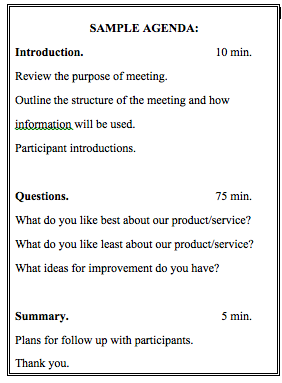“We need to collect a lot of information from a large number of people in a short period of time. Face to face input is important, but our group doesn’t have the time or the resources to gather this information through individual interviews. What do you suggest?”
#3: Focus Groups
What are Focus Groups?
Focus Groups are designed to gather information from groups of people. The need for this technique can be motivated by time constraints, or the belief that the synergy of group discussions can create more input and ideas than one-on-one discussions.
Focus Groups are not recommended when you want quantitative or statistical types of information but are excellent at providing qualitative information. Focus Groups can also be extremely effective when used in combination with individual interviews and questionnaires.
Focus Groups are usually discussions with groups of eight to twelve people, and these groups generally contain a homogeneous selection of participants, that is, a group of suppliers, customers, or employees from a specific department or level within an organization. Discussions usually last from one and a half to two hours and are facilitated by an interviewer or moderator. Data collected from a Focus Group is generally used outside the Focus Group itself. The data provides information that the organization can use to improve its’ competitive position, its existing or future products or services, its work processes, or its organizational culture.
When Do I Use Focus Groups?
- When you want to gather information from a large number of people in a short amount of time
- When you want to determine how specific decisions and/or actions are perceived within the organization
- When you want to test the clarity of communication
- When you want to generate hypotheses or new ideas
- When you want to plan an organization-wide questionnaire
- When you want to evaluate another group’s ideas
- When you are unfamiliar with opinions of specific groups and want a broad view quickly
How Do I Use Focus Groups?
1. Clarify the information needed, why it is needed, and how it will be used. Agree that Focus Groups (or another technique) is the best process to gather the necessary information.
2. Determine who you will include in your Focus Group(s). Examples include specific teams or departments; groups of suppliers or customers; groups of executives, managers, or board members; community members; and special-interest group members.
NOTE: Homogenous groups where group members have something in common with each other work best.
3. Determine the questions you will ask as well as the format of those questions.
NOTE: Use introductions as a technique to help participants become comfortable with each other. It is difficult for participants to be open without knowing who else is in the room. Food and beverages also give the meeting a more comfortable feel.
Prepare an agenda for each Focus Group. An example is below.
4. Determine who will facilitate or moderate each Focus Group. To insure neutrality, consider using an external facilitator or a combination of internal and external persons.
5. Determine how to document the information collected in the Focus Groups. Chart responses, video or tape record responses, have a second person take notes during the meeting, or use a combination of these.
6. Decide how information will be summarized. For instance, cluster in categories of information, categorize by focus group, or categorize by question asked.
7. Prepare invitations for Focus Group attendees, including the following:
- Purpose of the Focus Group
- Who will be attending
- Why and how participants were selected
- Time and place
- Duration of the meeting
- Who will moderate/facilitate the Focus Group
- Incentives for attendance, i.e. food, gifts, etc.
- Request for confirmation of attendance
NOTE: Ensure that invitations are sent by a person who will be able to influence participants to attend, i.e. a line manager, an executive, or other person of influence.
8. Prepare the logistics for the meeting.
9. Conduct the Focus Group.
10. Use the information as planned.
NOTE: In addition to entire books on the subject of Focus Groups, a number of professional organizations provide expertise in conducting Focus Groups. The information provided here is designed to provide the fundamentals for facilitating Focus Groups.
In Summary:
Focus Groups help gather qualitative information from large groups of people in a minimum amount of time. Although not recommended for quantitative, very negative, or controversial information, Focus Groups can create a synergy that stimulates more input and ideas than one-on-one discussions.
- Determine what information is needed and agree that Focus Groups are the best technique for gathering that information.
- Determine who will be included in the Focus Group or groups, and who will send the invitation to attend.
- Determine the questions you will ask.
- Determine who will moderate the Focus Groups.
- Determine how to document the collected information.
- Decide how the information will be summarized.
- Prepare invitations.
- Prepare the logistics.
- Conduct the Focus Group(s).
- Use the information as planned.
———————-
NOTE: If you would like to receive e-mail notification when I post additional techniques, please sign up through this link. http://eepurl.com/KILan You may unsubscribe at any time.
